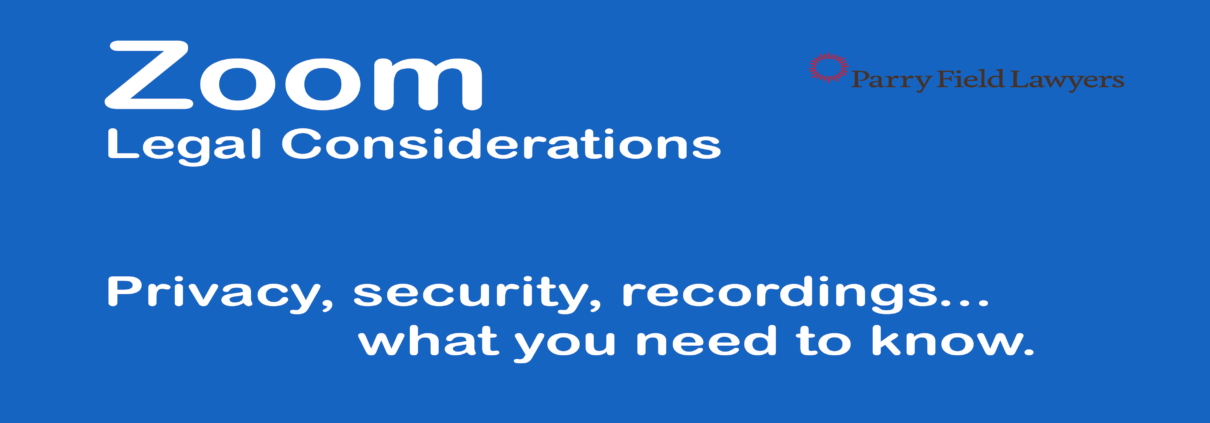A few weeks ago not many of us had even used Zoom video conferencing – today it has become a daily way of checking in with colleagues or clients, or holding large scale meetings, even virtual Friday drinks. In fact it has gone from 10 million users in a day to 200 million. But from a legal perspective is there anything we should be aware of and what is the best practise when it comes to keeping our communications secure?
Here we are going to talk about some of the recent incidents and explain some of the features of Zoom that might help. We also want to consider the recording function on Zoom – does that mean you can just record anything? We will finish off with some other things we have noticed when using Zoom – including privacy considerations.
Recent incidents involving Zoombombing
Zoombombing is where someone uninvited joins a call and disrupts the meeting. With a lot more use there are a lot more things being reported. In Singapore some online classes were Zoombombed recently. In the US a small community – where everyone pretty much knows each other – held an event due to the lockdown, and had people join it and share inappropriate images. When the people were kicked out of the meeting they came back in posing with names of legitimate people from the community, and continued posting so the meetings had to shut down.
It seems likely that this will increase in future – and if you have a larger meeting then it is more likely the invite has been forwarded on to others who might take advantage of the platform provided by your meeting.
So what are some strategies to keep communication safe?
There are a few things you could try doing – some within the app itself and others are just common sense. These include:
- Set a password – while this adds an extra administrative task for those joining the call, it is also an extra level of protection as you can require people to enter a password.
- Have a waiting room – if you do this then you can see who wants to join the call, and it allows an extra way to vet people before they join. Particularly if there is some reason to worry someone might come uninvited it is worth considering.
- Keep your ID secret – When sending out information just send the unique meeting ID without also including your personal meeting ID, that will help to stop people trying to log into another room of yours at other times.
- Other tools – it is possible to mute everyone, disable screen sharing by others apart from the host, or lock out some people – have a play around with the settings.
- Use another platform? Remember when Skype was first introduced? It was the original Zoom and still is there, providing another way to hold video calls with people. Other ways we see being used include Whatsapp and Facebook Messenger. While we haven’t used these we know that Google Hangouts and Microsoft Teams are also good. If you are worried and the calls are with one other person mainly then those might be options to consider. Of course, similar privacy and security considerations will apply no matter which platform is chosen.
It is important to implement such strategies, especially if you are discussing the personal information of others. In the current situation, many workplaces are trying to maintain the approach of business as usual as much as possible through the use of Zoom. Therefore, you need to be mindful when discussing personal information of clients or customers, even if this occurs in an internal meeting, that you adhere to Privacy Principle 5 in the Privacy Act 2020. This principle is designed to protect personal information from unauthorised use or disclosure.
Generally the zoombombing happens when there is a widely shared link for the public to attend and learn more about a topic – those are easy prey. If you are having a small meeting or are confident that the links are going to a limited number of people then this is less likely to be an issue.
What about recording?
Just because you can record doesn’t mean you should if you don’t have consent. Obtain that at the start of each call if you are going to record. In New Zealand, the Privacy Commissioner has put out this briefing on “can I record someone without telling them” here. The basic principle is simple: get consent.
Privacy principle 3 in the Privacy Act 2020 is the most relevant and provides, among other things: “If an agency collects personal information directly from the individual concerned, the agency shall take such steps (if any) as are, in the circumstances, reasonable to ensure that the individual concerned is aware of …the fact that the information is being collected; and the purpose for which the information is being collected; and the intended recipients of the information …”
The Zoom privacy policy notes this about recording: “Your meetings are yours. We do not monitor them or even store them after your meeting is done unless we are requested to record and store them by the meeting host. We alert participants via both audio and video when they join meetings if the host is recording a meeting, and participants have the option to leave the meeting.”
The key principle here is simple: Let people know that you are recording and get their consent.
Privacy & Security
While the technical side can be confusing, Zoom provide guidance on how they encrypt things here. It is also worth taking a look at their privacy policy here. It’s always fascinating to get past the corporate language to read the actual wording – the nuts and bolts – of how they operate. Some of the key things are:
- They don’t sell personal data and only collect user data needed to provide the services;
- They do not monitor meetings but do allow users to record them; and
- They have a separate policy that applies to children and younger users;
It’s interesting to read in some of the detail of what features there are – for example there is an attention tracker: “This feature … places a small clock icon next to a participant’s name to indicate only to the host when Zoom is not the active window on the participant’s computer for more than 30 seconds, when the host is sharing their screen.”
The CEO of Zoom published this post recently and committed to openness and transparency and they do seem to have taken a number of steps. Part of that said: “Transparency has always been a core part of our culture. I am committed to being open and honest with you about areas where we are strengthening our platform and areas where users can take steps of their own to best use and protect themselves on the platform.”
Virtual Backgrounds
When we think about privacy one other way is to make use of the virtual background feature of Zoom – that stops people seeing your private space. Remember if things get recorded then screen shots and recordings can stick around for a long time. Virtual backgrounds help. You can choose images provided by Zoom or create custom ones. It can be a useful tool to know how to use.
How to change Zoom background on your desktop app:
- In the Zoom app, click your profile in the top right corner, and click icon (settings).
- A menu will appear to the left, click ‘Virtual Background’.
- Default background options provided by Zoom will appear. You can choose one of those by clicking on it (ensure ‘I have Green Screen’ is unticked).
- Alternatively, you can upload your own photo. Click the + icon next to where it says ‘Choose Virtual Background’. A box will appear allowing you to upload a photo from your computer. Click on the one you want, and it will appear alongside the other pictures as an option for you to choose from.
How to change Zoom background on your mobile app:
- You need to be in the meeting to change your background.
- Click on ‘More’ in the bottom right hand corner, then click on ‘Virtual Background’.
- Default options are provided, or you have the option of uploading your own picture from your Camera Roll.
The ability to change backgrounds in Zoom has seen many get creative in order to lighten the mood in these uncertain times. Whether you want to hide the mess that lurks behind you, or you would just like to pretend for the next while you are on that tropical vacation that you never got the chance to take. You might even want to be in a scene of your favourite TV show! The options are truly endless. Why not bring a bit of excitement to meetings, and keep your colleagues guessing by changing up your Zoom background every time?
Conclusion
This crisis has introduced many new things and accelerated the adoption and use of certain technology like Zoom. While that move is likely to be permanent and in person meetings may reduce – why travel from Christchurch to Auckland for a meeting if it can be done simply from home? It does pay to be aware of the different features that make holding your meetings more secure and also ensure you do not fall on the wrong side of the law when it comes to recording them.
This article is not a substitute for legal advice and you should contact your lawyer about your specific situation. Please feel free to contact Steven Moe at stevenmoe@parryfield.com or Kris Morrison at krismorrison@parryfield.com should you require assistance.




